- 한국어
- English
- 日本語
- 中文
- العربية
- Español
- Français
- Deutsch
- Pусский
- Tiếng Việt
- Indonesian
Trends in education have caught up with the rapid development of high-speed Internet, smart devices, and software. Schools of Sejong Metropolitan Autonomous City are leading this change.
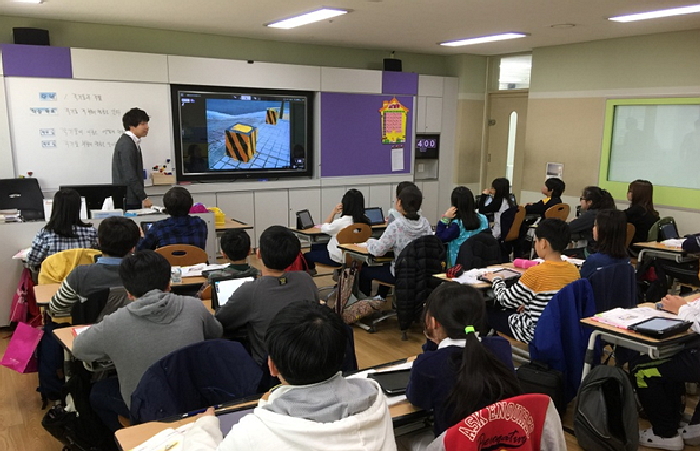
Digital boards are used by Chamsaem Elementary School in Sejong.
Digital boards are large screens that can communicate two ways between the teacher and the individual smart pads held by students. The screen shows if students are logged on to the education system and can also transfer material directly to the students' tablet screens. Completed work on each student’s device can be sent to the main screen to be shared with the entire class.
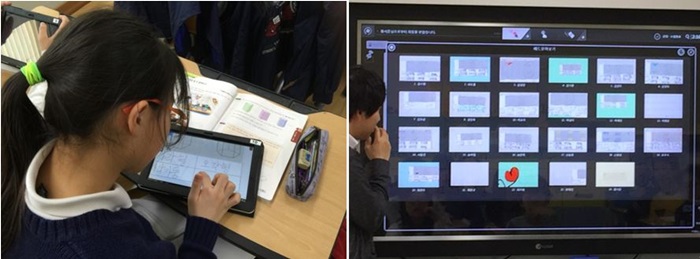
A student fills in the blanks on her tablet device (left). A teacher checks the work submitted by his students (right).
Another special school feature is the video conference room. Students can watch and talk with other students from anywhere around the world, seeking out diversity beyond geographic limits and language barriers. Shin Seung-hwa, a sixth grader, spoke of her experience video conferencing with a American peer as the highlight of her school experience.

Video conference system (left). The principal and colleagues hold a conference with counterparts in Australia (right).
The classroom and corridor are divided by a wall with smog glass, normally clear but opaque when electricity is turned on. These windows act as additional screens to the main one installed at the front of the classroom, making it possible to watch three screens at once.
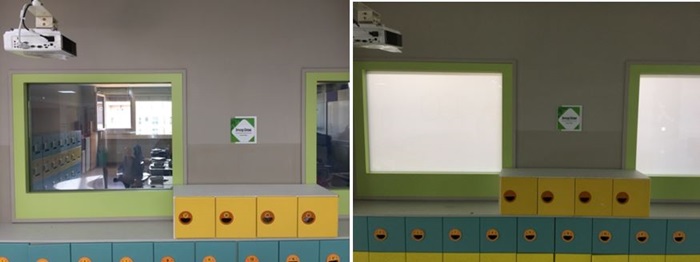
Smog glass is clear (left) naturally, but becomes opaque when electricity is applied (right).
The entire school program is not solely run on smart education. Differing from school to school or class to class, smart education is applied to 15 to 30 percent of the classes that find the method useful.
Smart devices are useful in research, lessons requiring maps or studying 3D objects in math, and ultra speed photography encourages better posture in physical education.
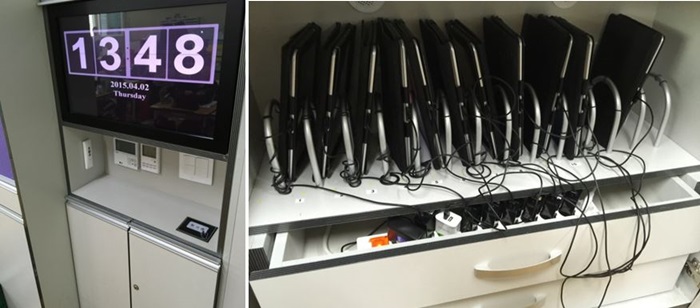
Electronic scanners attached to the cabinet provide attendance records (left). Students place their used smart devices in charging stations (right).
Student ID cards equipped with electronic chips conveniently take roll call through scanners at the front of the classroom.
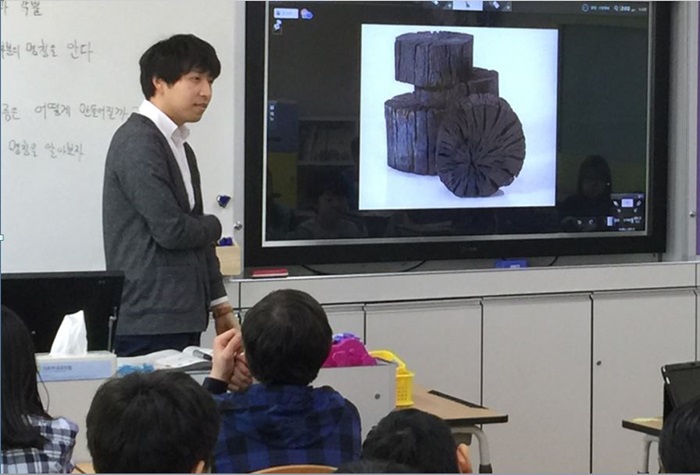
Teacher Ha Beom-su’s class at Chamsaem Elementary
Korea.net talked to teacher Ha Beom-su at Chamsaem Elementary, teacher Jeong Woo-young at Dodam Elementary, fourth-grade students at Dodam Elementary and a parent.
- What are your thoughts as a teacher applying smart education in class?
Smart education encourages students to rediscover digital devices as a means of new information beyond hardcopy textbooks, devices useful in life, rather than as a means of entertainment only. (Ha Beom-su)
Smart technology has in fact enabled efficient school management, better parent-teacher communication, increased exchange between schools and classes, and sharing photos and video work through social networking services. (Jeong Woo-young)
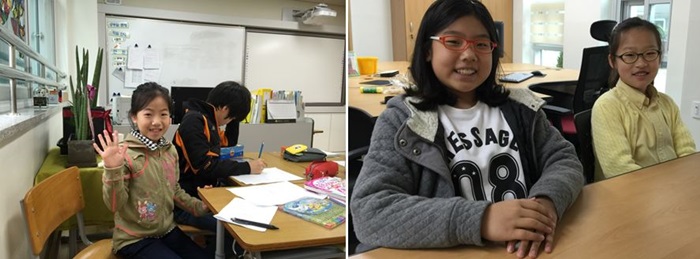
Fourth graders at Dodam Elementary: (from left) Lim Jinah, Jeong Dayeon, Noh Subin
-Are there any differences in before and after beginning smart education?
Of course. I experienced smart education for the first time this year. Subjects like Korean, math, arts and culture use it most and the best time was when we made an animation with an app. (Lim Jinah)
-What are the ups and downs of smart education?
Smart devices are useful for searching for information but it takes away the opportunity to handwrite. (Jeong Dayeon)
We can look for information beyond our textbooks but it also allows us to wander elsewhere. (Noh Subin)
-Personally what activity do you enjoy with smart devices?
I particularly enjoy playing “Crossy Road,” a mobile game with animal and people characters. (Lim Jinah)
-What part of elementary school do you like best?
I like PE and music class the best. “Kick run ball” involves defense and offense and is particularly fun. (Lim Jinah)
PE and group physical activities are fun. Math, science experiments and watching animals and plant activity is also a good experience. I like reading sessions during Korean class. (Jeong Dayeon, Noh Subin)
-What would you like to say to (young) readers of Korea.net?
Please visit Korea! Try local cuisine and play with us on seesaws and swings. I can name countries like Switzerland, Canada, US, Italy, Czech Republic, France, Kenya, Vietnam, India and Australia. (Lim Jinah)
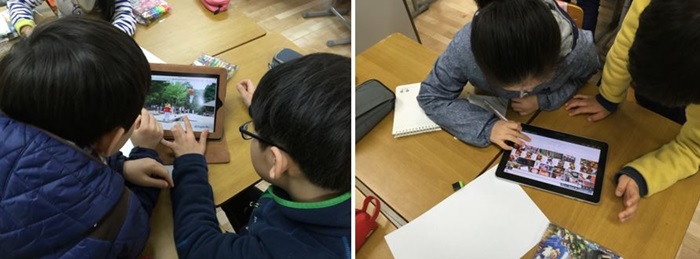
Fourth graders at Dodam Elementary prepare a UCC video to submit to the UNESCO World Education Forum with 192 countries in attendance. The video’s topic is “Introducing Korean Culture” and the smart devices help them do research and translate material into other languages.
- Do you have any advice to offer schools or teachers hesitating to adopt smart education?
Teachers that find smart devices unfamiliar can ask students with the knowledge to help out. This can be an educational experience in offering help, being thanked and fostering pride. (Ha Beom-su)
Realistically not every student can individually access smart devices and one teacher can have difficulty in teaching all the students how to use the device. By tasking the fast learners as helpers teaching other students, the children gain an opportunity to help each other and work together enabling efficient study as a whole class. (Jeon Woo-yeong)
- Are there any differences in education in cities other than Sejong?
Compared to cities with higher population density, Sejong has smaller class sizes that can concentrate on people-to-people relationships rather than just grades. Since it is a relatively new city it lacks a variety of afterschool activities and facilities. Still I think that it is important that kids get more experience and discover what they wish to do through it. (Parent)
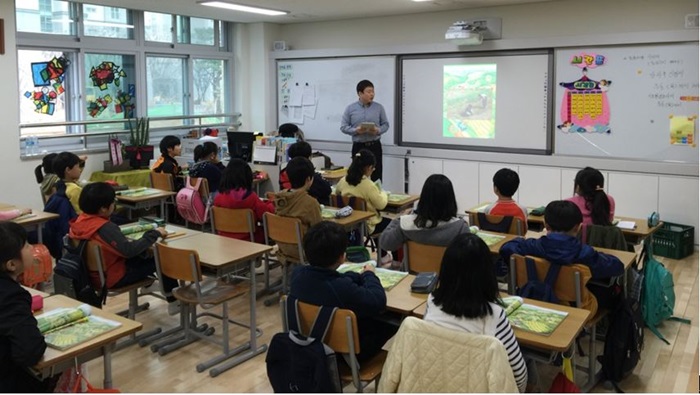
Jeong Woo-young teaches a class at Dodam Elementary
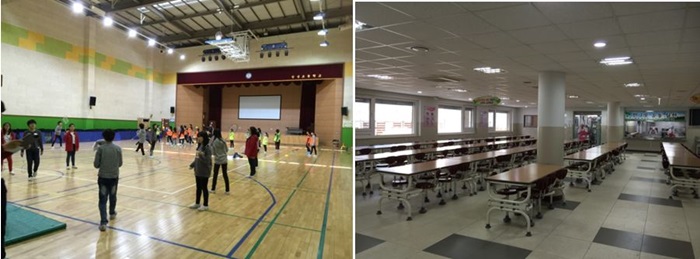
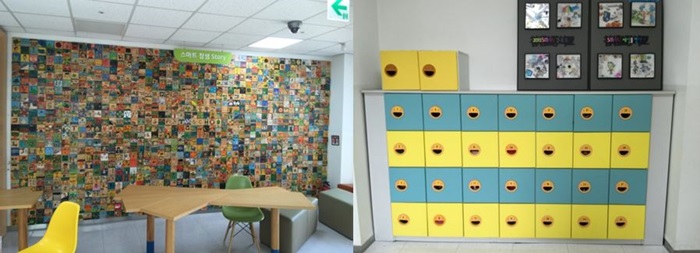
Facilities at Chamsam Elementary (Starting from top left): multipurpose gym, cafeteria, art wall, lockers
By Paik Hyun
Korea.net Staff Writer
cathy@korea.kr